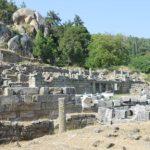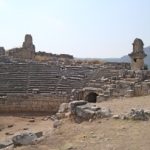I’d come to Ardeşen, due east of Rize, in search of its famous hawkers but alas I’d come too late. In the local teahouse they were very apologetic. August, they said. September. But look, here on the wall were photographs of sparrowhawks in all their splendid plumage and here by the window was a copy of a ferman issued by Sultan Selim I in 1516 requesting that the best birds be reserved for the Topkapı kitchens.
Actually it wasn’t the end of the world that I’d come on the wrong day because right outside the teahouse the local market was in full swing. As anyone who’s lived in Turkey for long will know these local markets have a certain sameness about them. There will always be stalls piled high with fruit and veg, rails of cheap jumpers and piles of plastic kitchenware. More rarely will there be anything truly unusual, so I was pleased to find that Ardeşen’s still managed a tiny livestock section where local men and one bossy woman were weighing up the respective merits of caged hens and roosters on leashes. Nearby, too, there were boxes full of what looked like very brown plums with little cardboard caps on them. These, when I enquired, turned out to be hurmas (dates), but not your run-of-the-mill dates, oh no – these were Georgian imports, a reminder of how close this corner of Turkey is to the Caucasus.
“We sell them all over the country,” the stallholder told me. “In Kayseri, in İstanbul. Mind you, they’re expensive there. You’ll see them in the Spice Market for TL30 a kilo.”
I tried one and found it sweet, juicy and unexpectedly devoid of a stone. Just down the road a man who studiously avoided my enquiring eye was selling all sorts of local cheeses, some of them mildewed and pungent although none as visually striking as the ones piled up outside the shops in Rize like so many yellow frisbees.
Elsewhere there were boxes stacked with kindling wood and topped off with hefty woollen socks made of rough undyed wool that looked as if they would make the wearer’s feet itch dreadfully. The only man I actually saw wearing such socks had them tucked into rubber over-slippers, not a style I could see catching on anywhere outside Lazland.
Round the perimeter of the market were permanent stalls selling fresh fish, including trays of slippery, silvery Black Sea hamsi (anchovies) and some extremely plump and lengthy alabalık (trout). Tucked in between them I found the same small lokanta in which I’d tasted a delicious fish soup back in June. The owner recognised me at once. “Welcome,” he called and ushered me cheerily to a table.
This ramshackle, inviting lokanta could hardly be less like the rest of Ardeşen, a town for which the term betonville (concrete town) might have been invented, its high street one long, dreary canyon of identikit apartment blocks with shops on the ground floor. There’s not a thing of beauty or interest to mark it out from the other Laz towns on either side of it – Çayeli and Pazar to the west, Fındıklı and Arhuvi to the east. Yet here, in between the fish stalls, was a little piece of bohemia, if one can really talk of bohemia in relation to fish.
Heart of this tiny place was an old-fashioned wood-and-coal-burning stove that was belching out enough heat to keep its patrons happy. On top of it the owner’s wife lifted the lids on an assortment of cooking pots to show off a choice of Black Sea favourites. There was the fish soup again, but there too was hamsi pilavüstü (anchovies on rice), lahana (cabbage) and lahana ezmesi, cabbage with a bite to it. I ordered samples of everything and retreated to mop it all up with big hunks of chewy mısır ekmeği (corn bread) and hamsi ekmeği (anchovy bread).
In the summer I’d been able to sit outside in the pocket-handkerchief-sized courtyard but in front of me the sea had been blocked from view by the new Black Sea Highway. “It used to come right up to our windows,” the owner said ruefully. “We could hang a fishing rod out of the window.” Compensation, I asked, while knowing perfectly well what the answer would be. “They’re talking about raising us up on stilts,” he said. “But it will end with us. My children aren’t interested.”
While I was tucking into my mini feast an elderly woman in a thick red cardigan wandered in. She, too, took a look at everything, then after a lot of toing and froing chose the bread. Not that I could understand a word she was saying since she was speaking Lazca. Once she’d gone I fell to talking to two men at the next table. Yes, they told me, most people round here still spoke Lazca although their children learnt Turkish at school. “So it’ll start to die out,” I said.
“Oh no,” they replied. “The children still understand it because their parents speak it at home.”
“But if they don’t practise it…”
We passed hastily over that, and they started to tell me about the language. “It’s not at all like Turkish,” they said, “And there are some words that are virtually the same in Greek.” Which I suppose is not really that surprising considering that until the 1923 population exchange the minority Rum (Greeks) and Laz peoples would have been living side by side on the coast for centuries.
My bill came to the grand sum of TL10. Afterwards I stepped back out into the market and noticed something else that was different about Ardeşen. A man walked past pushing a barrowload of red and yellow boxes of rat poison. No sooner had he gone than a second followed him, then a third right behind him. Women gathered round the men enquiring about prices and pushing boxes into their shopping trolleys. “Only one,” I heard a woman say. “It’ll be spring soon.”
“Do you get a lot of rats around here?” I eventually asked one of the stallholders, afraid that he would think me rude but quite certain that Göreme market wouldn’t be able to sustain one rat poisonci let alone three. “Oh yes,” he said. “After they harvest the corn we get them. And after the hazelnuts. But then it’s spring and that’s the end of it.”
Written: 23 February 2012


